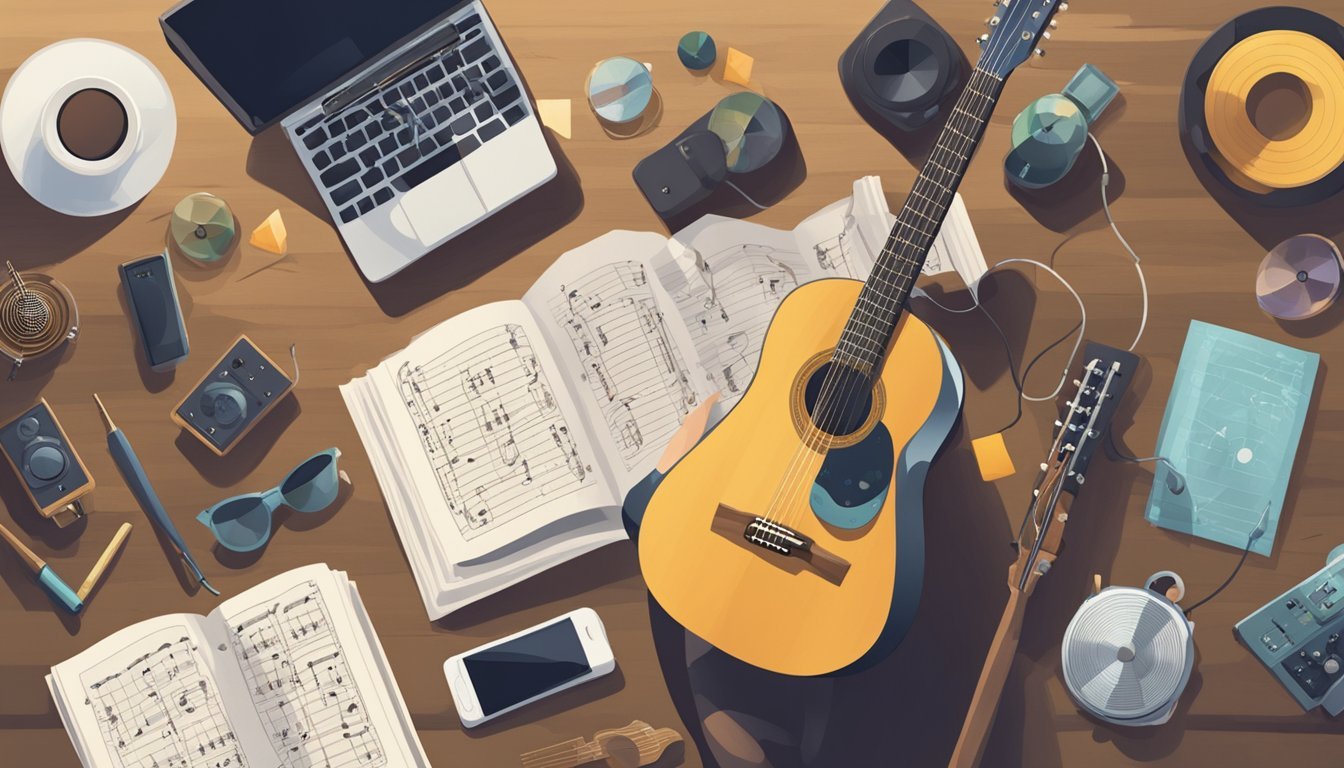Starting your guitar journey is an exciting adventure, but many beginners wonder how long it truly takes to learn guitar. With dedicated practice, you can reach a comfortable playing level in about 6 months to 2 years. This includes learning basic chords, strumming patterns, and a few songs.
As you continue to practice and expand your skills, you might find yourself becoming more confident and creative with your music.

The path to mastering the guitar depends on a few factors, like how often you practice and the goals you set for yourself.
Each player’s journey is unique, and your progress can vary based on your dedication and the techniques you use.
Remember, enjoying the process is just as important as reaching any milestones along the way.
Whether you’re just picking up the guitar or looking to advance your skills, understanding what to expect can help keep you motivated.
Let’s dive deeper into the various stages of learning guitar and how to make the most out of your musical journey.
Key Takeaways
- Achieving basic skills takes about 6 months to 2 years.
- Consistent practice is key to improving your guitar skills.
- Enjoying your musical journey makes learning more fulfilling.
Getting Started with Guitar

Starting your guitar journey involves a few key steps.
You need to choose the right instrument, understand its parts, and learn basic techniques that will set the stage for your progress.
Choosing Your Instrument
When choosing a guitar, you may face the decision between an electric guitar and an acoustic guitar. Acoustic guitars are great for beginners because they don’t require additional equipment like amplifiers.
They’re also perfect for playing chords and strumming.
Electric guitars offer versatility and can produce a wide range of sounds but need an amplifier.
Visit a music store to try out different guitars.
Pay attention to how each one feels in your hands.
You want something comfortable.
Don’t forget to think about your budget.
A good beginner guitar can range from $100 to $500.
Understanding Guitar Anatomy
Knowing your guitar’s anatomy is essential.
Key parts include the body, neck, and headstock.
The body is where the sound resonates, while the neck is where you fret the notes.
The headstock holds the tuning pegs, which help you keep your guitar in tune.
Fretted notes come from pressing your fingers on the strings along the neck.
Make sure to familiarize yourself with terms like frets, strings, and pickups for electric guitars.
Also, learning how to use a guitar tuner can help ensure your instrument always sounds its best.
Basic Guitar Techniques
As a beginner guitarist, start with the basics.
Practice holding a guitar pick and strumming the strings.
Begin to learn basic chords like open chords which allow you to play many popular songs.
Here’s a short list of beginner chords to start with:
- G major
- C major
- D major
- E minor
Focus on switching between these chords to improve your finger dexterity.
Strumming patterns are also essential.
Start with simple downstrokes, then combine down and upstrokes for variety.
With consistent practice, you’ll build a strong foundation for more advanced techniques down the road.
Practice Makes Perfect
When learning guitar, practice is the key to improvement.
Developing a structured routine, facing challenges head-on, and keeping track of your progress can make all the difference in your journey.
Creating a Practice Routine
Establishing a regular practice routine is essential.
Aim for at least 30 minutes a day, focusing on different aspects like chords, scales, and strumming.
Consistency helps reinforce what you learn.
Start with warming up your fingers.
Exercises that build calluses and flexibility are important.
Then, practice chord transitions, which are often tricky but crucial for playing songs smoothly.
Try breaking your sessions into segments.
For example:
- 10 minutes: warm-up exercises
- 15 minutes: chord practice
- 5 minutes: playing a song
Having a clear plan gives your practice purpose and keeps you motivated.
Overcoming Common Challenges
It’s common to face obstacles while learning guitar.
You might struggle with chord transitions or feel frustrated by the learning curve.
Remember, patience is key.
Take breaks when you feel stuck.
Sometimes stepping away can give you a fresh perspective.
Focus on shorter sessions when you’re feeling overwhelmed.
Also, find an ideal learning environment.
A quiet space with minimal distractions helps you focus better.
Don’t hesitate to ask for help or take guitar lessons for extra guidance.
As you practice regularly, you’ll notice gradual improvement.
Celebrate small victories, like mastering a difficult chord!
Tracking Your Progress
Tracking your progress keeps you motivated.
Use a simple chart to note what you learn each week.
By writing down what you practiced and what you want to improve, you create a roadmap for your growth.
For example:
- Week 1: Basic chords learned
- Week 2: Improved chord transitions
- Week 3: Played a full song
Review your notes frequently.
It’ll help you see how far you’ve come.
This can be a huge boost, especially when you feel like progress is slow.
Remember, every bit of practice counts, and it all adds up over time.
Expanding Your Skills
As you get comfortable with the basics, it’s time to expand your skills.
Focusing on advanced chords, music theory, and playing simple songs can make your guitar journey more enjoyable and fulfilling.
Here’s how you can dive deeper into each area.
Mastering Advanced Chords
Once you’ve grasped basic chords, start exploring barre chords.
These chords use one finger to press multiple strings across the fretboard.
This technique allows you to play in different positions, which can help you unlock new chord progressions.
Try learning common barre shapes like F and B. These are great building blocks.
Practice switching between open chords and barre chords to improve your finger strength and dexterity.
Don’t forget about sus and add chords.
These add color to your playing and can make a simple song sound richer.
Spend time mastering these shapes to enhance your rhythm and lead guitar skills.
Exploring Music Theory
Understanding music theory can elevate your playing.
Learn how chords fit together in a song.
Familiarize yourself with scales, especially the major and minor scales.
This knowledge helps you craft your own guitar solos and improvise effectively.
Start by learning the Circle of Fifths.
This tool helps you see relationships between keys and discover chord progressions.
Additionally, knowing how to read sheet music or tablature will boost your playing confidence.
If you want to impress your friends, understand how rhythm works.
Learn about time signatures and how to count beats.
This foundation will make you a more versatile player.
Learning to Play Simple Songs
Playing simple songs is a fun way to practice.
Start with popular songs that use basic chords.
You can find many lists of guitar songs perfect for beginners.
Aim for songs with repetitive structures, as they help you build confidence.
Focus on songs like “Knockin’ on Heaven’s Door” or “Wonderwall.” These tunes often combine basic chords with straightforward strumming patterns.
As you play, pay attention to alternating picking to improve your technique.
As you progress, try playing along with recordings or using a metronome to develop your timing.
This practice will prepare you for more complex songs later on.
Remember, the goal is to enjoy the music while you learn!
Frequently Asked Questions
Learning guitar can be a fun journey, but you might have some questions about how long it really takes.
Here are answers to some of the most common questions people have.
The time it takes to learn the guitar depends on various factors, including your dedication, practice routine, and previous musical experience.
For those wondering how long to learn guitar, it typically takes a few months to grasp the basics, while achieving proficiency can take several years of consistent practice.
Remember, everyone’s journey is unique, and progress may vary, but enjoying the process is what truly matters.
Can you really learn guitar in just 3 months, or does it take longer?
Yes, you can learn some basic skills in about 3 months with consistent practice.
During this time, you should be able to strum some simple chords and play a few songs.
If you want to advance further, it will take more time and effort.
What’s a realistic timeline to start jamming on a guitar for a newbie?
For a newbie, you can start jamming within 3 to 6 months with regular practice.
You will need to focus on learning basic chords and songs during this time.
The more you practice, the quicker you will improve.
How quick can someone pick up chords when learning the guitar?
Most beginners can start picking up basic chords within a few weeks.
With daily practice, you can feel comfortable playing simple songs in just a month or two.
The key is consistency in your practice.
Does it make a difference in time to learn on acoustic versus electric guitar?
The type of guitar can affect your learning speed.
Generally, electric guitars are easier to play because the strings are lighter.
However, both types can be learned at a similar pace if you practice regularly.
How many years does it typically take to actually get good at playing guitar?
Getting really good at guitar can take several years.
Most people find that after about 2 to 5 years of consistent practice, they feel comfortable playing a variety of songs and techniques.
It’s all about dedication to your practice.
Is it faster to learn guitar by yourself or with lessons?
Taking lessons can speed up your learning process.
A teacher can provide guidance and feedback.
Learning on your own is possible too, but it might take longer to figure things out without assistance.
Choose what works best for you.

